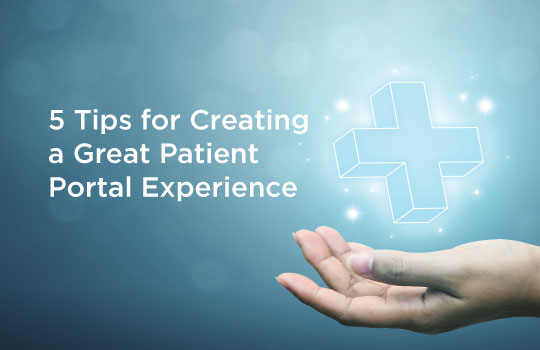
88% of healthcare leaders currently use or have plans to implement a patient portal for their organization.

This statistic, courtesy of the New England Journal of Medicine, represents a major shift in the way that patients and providers interact when it comes to the delivery of health care. It’s a shift towards digital instead of paper, towards greater communication between providers and their patients, and towards a more active role for patients when it comes to managing their health.
However, despite the many advantages of patient portals, getting people to sign up and use them has proven to be difficult for many healthcare organizations. In fact, the average overall adoption rate across the U.S. is only 29%.
Here are 5 tips to ensure that your patient portal will be a success:
Tip #1 The 6 Must-Have Portal Features
The following six activities are the foundation of a good patient portal and the bare minimum that your patients should be able to easily perform:
1. Schedule appointments and receive appointment reminders
2. Communicate with physicians through secure email and messaging
3. View lab/test results, health records, and clinical summaries
4. Check and order refills on prescriptions
5. Pay medical bills
6. Fill out pre-visit and post-discharge forms
There are two other very important features to include to increase patient engagement to consider.
The first is offering personalized recommendations to improve your patients’ health. For example, when test results reveal that a patient has high blood pressure, send them a list of 5 ways they can lower it. Keeping patients engaged with value-added information has proven to be key in increasing patient retention, which results in increased profits.
Secondly, the rise in popularity of mobile health apps and devices means patients have access to more of their own health data than ever before. Enabling them to upload their own data, not only improves patient engagement, it also gives healthcare providers access to this information in real-time to provide a more accurate diagnosis.
Tip #2 Proven Strategies to Increase Portal Adoption
No matter how many great features your patient portal has, you have to get people to actually sign up and use it. Here are some ways to encourage patients to register with your portal:
1. Promote the portal at every opportunity, including emails, electronic newsletters, posters, brochures, pamphlets, and on your website. You must also keep your website constantly optimized to keep garnering visitors. If you’re looking for expert help, Memphis web design services can ensure your site remains visually appealing and fully optimized. You can click here if you need help doing that. You may also consult this professional web designer dallas.
2. Get everyone in your organization involved. Sometimes the easiest way to get a patient to sign up is with your administrative staff when they come for an appointment.
3. Get creative with special offers, such as a contest or reduced charges for paying medical bills through the portal.
4. Inform patients about updates and new features to show you’re dedicated to continual portal improvements.
Tip #3 Make Your Portal Easy to Use
The most important tip on this list is making sure your patient portal is user-friendly and intuitive. If it’s difficult to navigate, slow, or has technical glitches it will be almost impossible to retain users. Consider these three steps to ensure portal usability:
1. Hire a professional User Experience (UX) designer to ensure it’s easy to navigate.
2. Hire a professional User Interface (UI) designer to ensure the design is visually appealing and adheres to your brand.
3. Test it with a diverse group of people and study the results to ensure anyone can accomplish simple tasks in a timely manner.
Tip #4 Plan Your Portal Implementation
As the saying goes, you only get one chance to make a first impression and if your portal lacks key features or is difficult to use, you will have an even harder time getting patients to give it a second chance. To ensure your portal offers a great user experience right out of the gate, test it with staff or a small group of patients before it goes live.
Tip #5 Use a Modern Integration Engine
The problem with many patient portals is that they’re not fully integrated with all of the provider’s systems. If key features like bill payment are missing it offers a less than ideal experience for users.
Iguana can ensure your patient portal is connected to all of your hospital and patient user systems including, EHR, LIS, billing system (click here to get medical billing and coding certification), medical devices, mobile apps, and wearables to ensure increased participation in your online portal and a more satisfying user experience.
